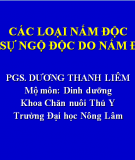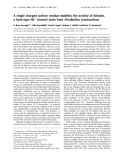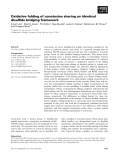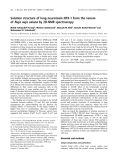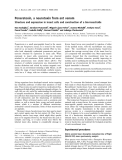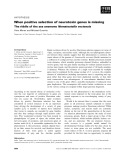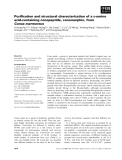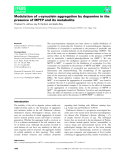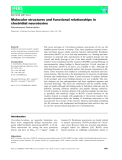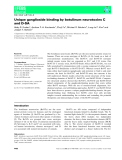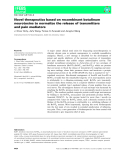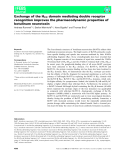
Neurotoxin
-
Chất độc tác động lên nguyên sinh chất tế bào (protoplasmic poisons): Nhóm chất độc thuộc loại này phá hủy các tế bào, từ đó nó làm hư hại một số cơ quan, tổ chức trong cơ thể. Nhóm độc tố tác động lên hệ thống thần kinh (neurotoxins): Nhóm chất độc này gây ra các triệu chứng thần kinh như: Sự ra mồ hôi quá độ, hôn mê, chứng co giật, ảo giác, chứng kích động, suy nhược, liệt cơ kết tràng... Nhóm chất độc kích thích đường tiêu hóa dạ dày - ruột (Gastrointestinal irritants): Nhóm chất độc này...
 94p
94p  peheo_1
peheo_1
 31-07-2012
31-07-2012
 250
250
 70
70
 Download
Download
-
Weak neurotoxins from snake venom are small proteins with five disulfide bonds, which have been shown to be poor bindersof nicotinicacetylcholine receptors.We report on the cloning and sequencing of four cDNAs encoding weak neurotoxins fromNaja sputatrixvenomglands. The protein encoded by one of them, Wntx-5, has been synthesized by solid-phase synthesis and characterized.
 10p
10p  research12
research12
 23-04-2013
23-04-2013
 46
46
 4
4
 Download
Download
-
We previously purified and characterized a peptide toxin, birtoxin, from the South African scorpion Parabuthus transvaalicus. Birtoxin is a 58-residue, long chain neurotoxin that has a unique three disulfide-bridged structure. Here we report the isolation and characterization of ikitoxin, a pep-tide toxin with a single residue difference, and a markedly reducedbiological activity, frombirtoxin. Bioassays onmice showed that high doses of ikitoxin induce unprovoked jumps, whereas birtoxin induces jumps at a 1000-fold lower concentration. ...
 8p
8p  tumor12
tumor12
 22-04-2013
22-04-2013
 42
42
 3
3
 Download
Download
-
Botulinum neurotoxin type A (BoNT⁄A), the most toxic substance known to mankind, is produced by Clostridium botulinumtype A as a complex with a group of neurotoxin-associated proteins (NAPs) through polycis-tronic expression of a clustered group of genes. NAPs are known to protect BoNT against adverse environmental conditions and proteolytic digestion. Hemagglutinin-33 (Hn-33) is a 33 kDa subcomponent of NAPs that is resistant to protease digestion, a feature likely to be involved in the protec-tion of the botulinum neurotoxin from proteolysis. ...
 10p
10p  awards
awards
 06-04-2013
06-04-2013
 33
33
 3
3
 Download
Download
-
Conotoxins are short, disulfide-rich peptide neurotoxins produced in the venom of predatory marine cone snails. It is generally accepted that an estimated 100 000 unique conotoxins fall into only a handful of structural groups, based on their disulfide bridging frameworks. This unique mole-cular diversity poses a protein folding problem of relationships between hypervariability of amino acid sequences and mechanism(s) of oxidative folding.
 12p
12p  awards
awards
 06-04-2013
06-04-2013
 43
43
 3
3
 Download
Download
-
The NMR solution structures of NTX-1 (PDB code 1W6B and BMRB 6288), a long neurotoxin isolated from the venom ofNaja naja oxiana, and the molecular dynamics simulation of these structures are reported. Calculations are based on 1114NOEs, 19 hydrogen bonds, 19 dihedral angle restraints and secondary chemical shifts derived from 1 Hto 13 C HSQC spectrum. Similar to other long neurotoxins, the three-finger like structure shows a double and a triple strandedb-sheet aswell as some flexible regions, particularly at the tip of loop II and the C-terminal tail....
 0p
0p  awards
awards
 05-04-2013
05-04-2013
 49
49
 2
2
 Download
Download
-
Poneratoxin is a small neuropeptide found in the venom of the antParaponera clavata. It is stored in the venom reservoir as an inactive 25-residue peptide. Here we des-cribe both chemically synthesized poneratoxin and pon-eratoxin obtained by expression in insect cells. When expressed in insect cells, poneratoxin was observed attached to cell membranes. Both synthetic and recom-binant ponerotoxins were soluble below pH 4.5. The structure of synthetic poneratoxin was characterized by circular dichroism and solved by nuclear magnetic reso-nance. ...
 10p
10p  dell39
dell39
 03-04-2013
03-04-2013
 37
37
 2
2
 Download
Download
-
Rapid evolution driven by positive Darwinian selection appears in toxins of vipers, scorpions, and marine snails. Although the vast phylogenetic distan-ces between these animals suggest that this phenomenon is common, the recent release of the genome ofNematostella vectensis(Starlet anemone) as a collection of contigs portrays another extreme.
 7p
7p  inspiron33
inspiron33
 25-03-2013
25-03-2013
 43
43
 3
3
 Download
Download
-
Cone snails, a group of gastropod animals that inhabit tropical seas, are capable of producing a mixture of peptide neurotoxins, namely conotoxins, for defense and predation. Conotoxins are mainly disulfide-rich short pep-tides that act on different ion channels, neurotransmitter receptors, or transporters in the nervous system.
 12p
12p  media19
media19
 06-03-2013
06-03-2013
 42
42
 2
2
 Download
Download
-
The neurotransmitter dopamine has been shown to inhibit fibrillation of a-synuclein by promoting the formation of nonamyloidogenic oligomers. Fibrillation ofa-synuclein is accelerated in the presence of pesticides and the neurotoxin 1-methyl-4-phenyl-1,2,3,6-tetrahydropyridine (MPTP).
 11p
11p  cosis54
cosis54
 05-01-2013
05-01-2013
 66
66
 2
2
 Download
Download
-
The seven serotypes ofClostridium botulinumneurotoxins (A–G) are the deadliest poison known to humans. They share significant sequence homo-logy and hence possess similar structure–function relationships. Botulinum neurotoxins (BoNT) act via a four-step mechanism, viz.,
 19p
19p  cosis54
cosis54
 04-01-2013
04-01-2013
 27
27
 5
5
 Download
Download
-
The botulinum neurotoxins (BoNTs) are the most potent protein toxins for humans. There are seven serotypes of BoNTs (A–G), based on a lack of cross-antiserum neutralization. The BoNT⁄C and BoNT⁄D serotypes include mosaic toxins that are organized as D–C and C–D toxins.
 11p
11p  cosis54
cosis54
 04-01-2013
04-01-2013
 35
35
 3
3
 Download
Download
-
A major unmet clinical need exists for long-acting neurotherapeutics to alleviate chronic pain in patients unresponsive to available nonaddictive analgesics. Herein, a new strategy is described for the development of potent and specific inhibitors of the neuronal exocytosis of transmitters and pain mediators that exhibit unique antinociceptive activity.
 13p
13p  cosis54
cosis54
 09-12-2012
09-12-2012
 49
49
 4
4
 Download
Download
-
The four-domain structure of botulinum neurotoxins (BoNTs) reflects their multistep intoxication process. The high toxicity of BoNTs primarily results from specific binding and uptake into neurons mediated by their 50-kDa cell-binding fragment (HC). X-ray crystallography data have revealed that the HCfragment consists of two domains of equal size, named the 25-kDa N-terminal half of HC(HCN) and the 25-kDa C-terminal half of HC(HCC).
 10p
10p  cosis54
cosis54
 09-12-2012
09-12-2012
 36
36
 3
3
 Download
Download
-
Tuyển tập các báo cáo nghiên cứu về y học được đăng trên tạp chí y học quốc tế cung cấp cho các bạn kiến thức về ngành y đề tài: "Binding of long-chain α-neurotoxin would stabilize the resting state of nAChR: A comparative study with α-conotoxin
 15p
15p  toshiba17
toshiba17
 28-10-2011
28-10-2011
 36
36
 2
2
 Download
Download
CHỦ ĐỀ BẠN MUỐN TÌM









